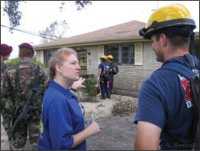Worker Safety After a Flood
The danger of a flood does not end when the rains cease. Cleanup crews must work together and look out for one another to ensure safety.
For most work in flooded areas, workers will need hard hats, goggles, heavy work gloves, and watertight boots with steel toe and insole (not just steel shank).
 Exposure to flood waters does not increase the risk of tetanus, and tetanus immunization campaigns are not needed. While documentation of vaccination is preferred, it should not be a pre-requisite for work. During flood cleanup, the risk of wounds may be increased. For this reason, cleanup workers should be sure that they are up-to-date with tetanus vaccination, ideally before starting cleanup activities. Adults need a tetanus booster shot every 10 years. Td or Tdap can be used; getting the Tdap instead of Td for one tetanus booster during adulthood is recommended to maintain protection against pertussis. Being up-to-date for tetanus vaccine can greatly simplify the treatment for any wound that might occur.
Exposure to flood waters does not increase the risk of tetanus, and tetanus immunization campaigns are not needed. While documentation of vaccination is preferred, it should not be a pre-requisite for work. During flood cleanup, the risk of wounds may be increased. For this reason, cleanup workers should be sure that they are up-to-date with tetanus vaccination, ideally before starting cleanup activities. Adults need a tetanus booster shot every 10 years. Td or Tdap can be used; getting the Tdap instead of Td for one tetanus booster during adulthood is recommended to maintain protection against pertussis. Being up-to-date for tetanus vaccine can greatly simplify the treatment for any wound that might occur.
First aid, even for minor cuts and burns, is very important during flood cleanup. Immediately clean all wounds and cuts with soap and clean water. Talk to a doctor or other health professional on the scene to find out if you need more treatment.
Excessive noise from equipment such as chain saws, backhoes, tractors, pavement breakers, blowers, and dryers may cause ringing in the ears and subsequent hearing damage. If you must shout over noise to be heard, you should wear earplugs or other hearing protection devices.
Additional Information
-
Storm, Flood and Hurricane Response
Work-related hazards that could be encountered include electrical hazards, carbon monoxide, musculoskeletal hazards, heat stress, motor vehicles, hazardous materials, fire, confined spaces, & falls. From the National Institute for Occupational Safety and Health (NIOSH). -
Traumatic Incident Stress: Information for Emergency Response Workers
Members of emergency response teams may be at risk for experiencing traumatic incident stress.
- Page last reviewed: August 28, 2017
- Page last updated: August 28, 2017
- Content source:


 ShareCompartir
ShareCompartir

